Jan
15
2010

6. Jesus Christ was not judge of the quick and the dead, because (according to preterists) He only judged the dead.
Jesus judged between the living and the dead in AD70. The true bride and the false bride were bodies of living people. Of course, part of the true bride was the Old Covenant saints (those “under the Altar”) who were dead.
Continue reading
4 comments | tags: Atonement, Daniel, David, High Priest, James Jordan, Leviticus, Peter Leithart, Postmillennialism, Saul, Temple | posted in Against Hyperpreterism, Biblical Theology
Jan
15
2010
Personal and structural…
“Jordan’s definition of the covenant is striking. Continue reading
Comments Off | tags: Covenant Theology, James Jordan, Marriage, Ralph Smith | posted in Biblical Theology, Quotes
Jan
8
2010
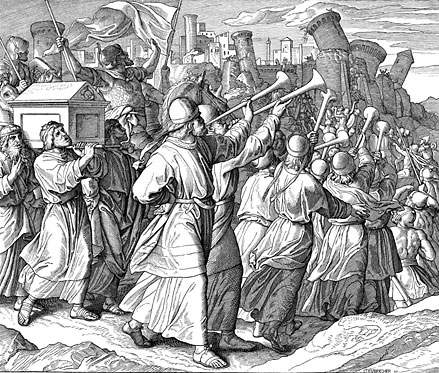
[Link to parts 1 and 2.]
In Revelation 4-5, Jesus ascends and opens the New Covenant scroll (Firstfruits). As Moses, He then opens the Law to Israel (Pentecost). These open seals lead into the partial judgments of the Trumpets. They summon a new generation of Israel and warn the old. The last trumpet, as in Joshua, is itself “seven thunders” (John’s “Little Book”) that bring total destruction to the defiant city, in this case, Herod’s Babylon (Atonement). This is the last trumpet Paul referred to.[1]
Continue reading
Comments Off | tags: Elijah, Feasts, James Jordan, Moses, Peter Leithart, Revelation | posted in Biblical Theology, The Last Days
Jan
7
2010
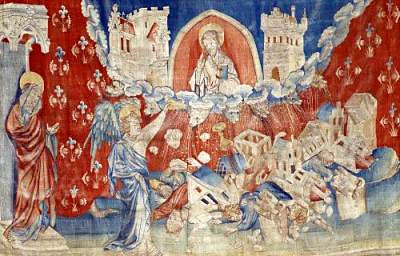
Revelation can’t be fully appreciated without attention to its literary structure. I’m no expert, but have a gander at this…
Continue reading
4 comments | tags: AD70, Atonement, David Chilton, Feasts, James Jordan, Literary Structure, Pentecost, Revelation | posted in Biblical Theology, The Last Days, Totus Christus
Jan
1
2010
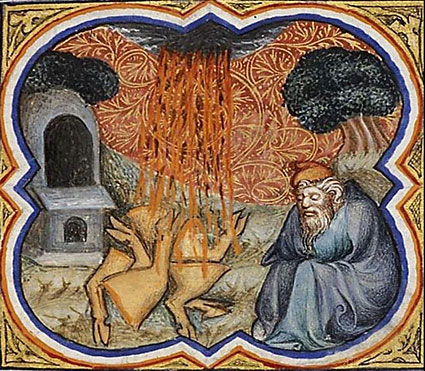
Luke 4:30 “But he passing through the midst of them went his way…”
Why did Abraham not cut up the birds?
The structure of the passage has a “Passover“. Abraham acts as a human firmament by chasing away the “Covenant curse” birds of prey, then falls into a deep, dark sleep.
Matching this chiastically at step 6, the smoking firepot and blazing torch pass through the divided pieces at Atonement. But not through the birds, obviously.
Did the clean birds represent the Covenant people, just as the scavenging vultures represented the Covenant curses? What sins did the sacrifice atone for?
Continue reading
Comments Off | tags: Abraham, Genesis, James Jordan | posted in Biblical Theology
Dec
17
2009
“Biblical concern for the poor and the oppressed is manifested through the actions of the church, not through the state. Liberalism, however, has always insisted that statist action, not ecclesiastical action, is the remedy, thus aligning itself with the Beast against the Bride. This is no small matter.”
— James B. Jordan, “The Moral Majority: An Anabaptist Critique” (a review of Robert E. Webber’s The Moral Majority: Right or Wrong?) in Christianity & Civilization #1: The Failure of American Baptist Culture. [PDF]
Comments Off | tags: Culture, James Jordan, Politics | posted in Quotes
Dec
12
2009
 An interesting excerpt from James Jordan’s review of Wayne House and Thomas Ice’s, Dominion Theology: Blessing or Curse?: An Analysis of Christian Reconstructionism
An interesting excerpt from James Jordan’s review of Wayne House and Thomas Ice’s, Dominion Theology: Blessing or Curse?: An Analysis of Christian Reconstructionism
The quietist is committed to inaction. The pietist, by way of contrast, is frequently active in social and charitable affairs, but what makes his position inadequate is that pietism is in general uninterested in social theory. (In general, pietist movements are not much interested in theology either.) There is no self-conscious reflection on the concerns of political philosophy in the broad sense. It is simply a matter of “doing good” here and there, without reflection. This is not bad, but it does not go far enough.
Continue reading
2 comments | tags: Dispensationalism, James Jordan, Philosophy, Pietism, Secular humanism, Theonomy | posted in Quotes
Dec
9
2009
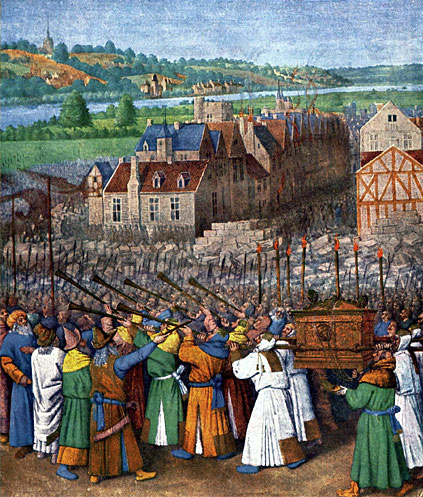
Excerpt from The Holy War in America Today: Some Observations on Abortion Rescues by James B. Jordan.
In the Old Covenant, after God set up the Tabernacle and constituted Israel as a nation, there were two kinds of war, first was Holy War, and the other was what we can call normal warfare.
Holy War (or herem warfare, as it is sometimes called, after the Hebrew for “ban”) was prosecuted in a special way, and only against certain people. There were five aspects of Holy War that made it different from normal warfare.
Continue reading
Comments Off | tags: James Jordan | posted in Biblical Theology, Christian Life, Quotes
Dec
8
2009
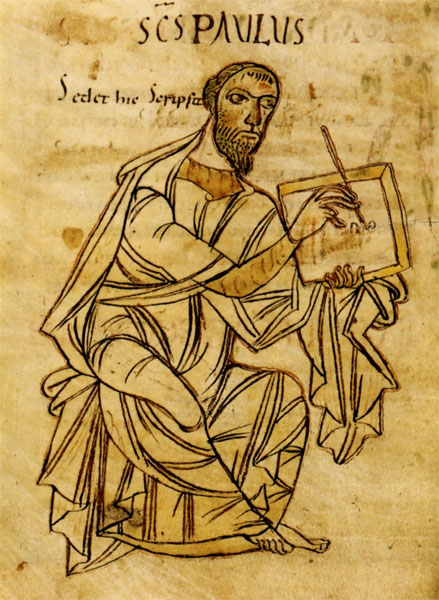
I say then, has God cast away His people? Certainly not! For I also am an Israelite, of the seed of Abraham, of the tribe of Benjamin. God has not cast away His people whom He foreknew. Or do you not know what the Scripture says of Elijah, how he pleads with God against Israel, saying, ”LORD, they have killed Your prophets and torn down Your altars, and I alone am left, and they seek my life”? But what does the divine response say to him? “I have reserved for Myself seven thousand men who have not bowed the knee to Baal.” Even so then, at this present time there is a remnant according to the election of grace. Romans 11:1-6
Romans 11 is one of those watershed passages. How one interprets it depends on one’s “plan of the ages” paradigm. If you haven’t read James Jordan’s The Future of Israel Re-examined, you need to. Due to its ramifications for interpretation of much of the New Testament, I believe it should be recognised as one of the most important writings of our time. It puts Romans, and especially chapters 9-11, fairly and squarely within a first century context. All would be fulfilled before AD70. God would make “a short work” in the Land. And He did.
It also helps with the interpretation of Revelation. Christ was a new Moses, just as Elijah was. He ascended and gave a double portion of His Spirit to the church as Elisha. The new body witnessed to Gentiles to provoke the hard-hearted Jews to jealousy. This has nothing to do with our day. It was a process confined to the end of the Old Covenant.
Continue reading
Comments Off | tags: Balaam, Hermeneutics, Herod, James Jordan, Jezebel, Paul, Romans | posted in The Last Days
Nov
28
2009

or Drive-By Typology
——————————————————————————-
Rome has this whole nutty Oedipus thing going. They want the infantile security of Mary’s breast when God calls them to grow up, to be as individuals men worthy of a bride’s affections, and corporately a bride who adores only her Husband!
——————————————————————————-
Verifying typological connections is a tricky business. Like driving, it is not a skill but an art. This means that although there are certain rules to follow, above all of that there are situations where being steeped in the types and structures of the Bible is the only way to proceed with wisdom. James Jordan recently commented that any such exegesis should be carried out within the conversation of the church, and:
“The popular notion that everyone should be able to read and exegete the Bible equally, as a result of learning some so-called “science” of hermeneutics, is about as stupid as thinking everyone can write music like Bach and Beethoven by studying the rules of harmony and counterpoint; or that anyone can be a Shakespeare.”
I’m no Shakespeare, but James Jordan’s identification of the biblical “universals” and an explanation of biblical types has helped me enormously. The Bible matrix structure has also helped me enormously. They are typological “systematics.” It is this kind of grounding, like practising scales on a piano, that enables us to more easily identify abuses of typology — such as the claim that Mary is a “New Eve.” Dischordant notes can be used to great effect in great music, but it takes a practised musician to know when it is within a greater “harmony” and when it is not. This is beyond the basic scales.
Continue reading
5 comments | tags: Athaliah, Baptism, Bible Matrix, Hermeneutics, James Jordan, Mary, Peter Leithart, Roman Catholicism, Systematic typology, Totus Christus | posted in Biblical Theology

































